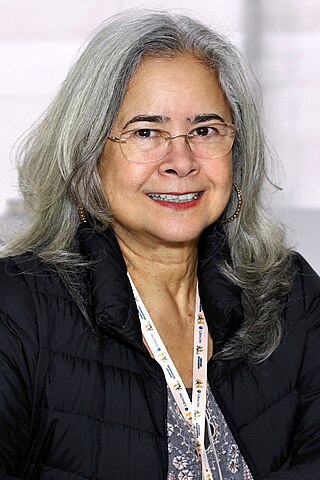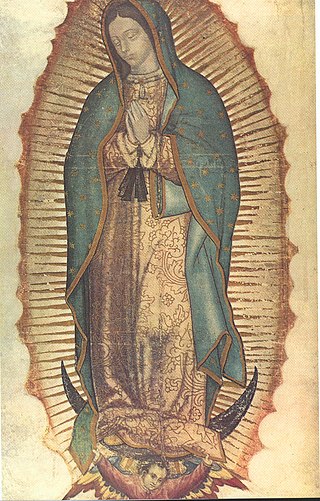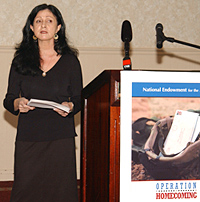Related Research Articles

Esmeralda Santiago is a Puerto Rican author known for her narrative memoirs and trans-cultural writing. Her impact extends beyond cultivating narratives as she paves the way for more coming-of-age stories about being a Latina in the United States, alongside navigating cultural dissonance through acculturation.

Míriam Colón Valle was a Puerto Rican actress. She was the founder and director of New York City's Puerto Rican Traveling Theater. Beginning her career in the early 1950s, she performed on Broadway and on television. She appeared on television programs from the 1960s to the 2010s, including Sanford and Son and Gunsmoke. She is best known as Mama Montana, the mother of Al Pacino's title character in Scarface. In 2014, she received the National Medal of Arts from President Barack Obama. She died of complications from a pulmonary infection on March 3, 2017, at the age of 80.
Latino studies is an academic discipline which studies the experience of people of Latin American ancestry in the United States. Closely related to other ethnic studies disciplines such as African-American studies, Asian American studies, and Native American studies, Latino studies critically examines the history, culture, politics, issues, sociology, spirituality (Indigenous) and experiences of Latino people. Drawing from numerous disciplines such as sociology, history, literature, political science, religious studies and gender studies, Latino studies scholars consider a variety of perspectives and employ diverse analytical tools in their work.

Marianismo is a Hispanic term that describes an ideal of true femininity with characteristics derived from the devotional cult of St. Mary of Guadalupe, a central figure of Roman Catholicism in Mexico. It defines standards for the female gender role in Hispanic American folk cultures, and is strictly intertwined with machismo and Roman Catholicism.

Judith Ortiz Cofer was a Puerto Rican author. Her critically acclaimed and award-winning work spans a range of literary genres including poetry, short stories, autobiography, essays, and young-adult fiction. Ortiz Cofer was the Emeritus Regents' and Franklin Professor of English and Creative Writing at the University of Georgia, where she taught undergraduate and graduate creative writing workshops for 26 years. In 2010, Ortiz Cofer was inducted into the Georgia Writers Hall of Fame, and in 2013, she won the university's 2014 Southeastern Conference Faculty Achievement Award.
Sexualization is the emphasis of the sexual nature of a behavior or person. Sexualization is linked to sexual objectification, treating a person solely as an object of sexual desire. According to the American Psychological Association, sexualization occurs when "individuals are regarded as sex objects and evaluated in terms of their physical characteristics and sexiness." "In study after study, findings have indicated that women more often than men are portrayed in a sexual manner and are objectified. In addition, a narrow standard of physical beauty is heavily emphasized. These are the models of femininity presented for young girls to study and emulate."

Stereotypes of Hispanic and Latino Americans in the United States are general representations of Americans considered to be of Hispanic and Latino ancestry or immigrants to the United States from Spain or Latin America, often exhibited in negative caricatures or terms. Latin America comprises all the countries in the Americas that were originally colonized by the Spaniards, French, or Portuguese. "Latino" is the umbrella term for people of Latin American descent that in recent years has supplanted the more imprecise and bureaucratic designation "Hispanic." Part of the mystery and the difficulty of comprehension lie in the fact that the territory called Latin America is not homogeneous in nature or culture. Latin American stereotypes have the greatest impact on public perceptions, and Latin Americans were the most negatively rated on several characteristics. Americans' perceptions of the characteristics of Latin American immigrants are often linked to their beliefs about the impact of immigration on unemployment, schools and crime.
White Hispanic and Latino Americans, also called Euro-Hispanics, Euro-Latinos, White Hispanics, or White Latinos, are Americans of white ancestry and ancestry from Latin America. It also refers to people of European ancestry from Latin America that speak Spanish natively and immigrated to the United States.
Nicholasa Mohr is one of the best known Nuyorican writers, born in the United States to Puerto Rican parents. In 1973, she became the first Nuyorican woman in the 20th century to have her literary works published by the major commercial publishing houses, and has had the longest creative writing career of any Nuyorican female writer for these publishing houses. She centers her works on the female experience as a child and adult in Puerto Rican communities in New York City, with much of writing containing semi-autobiographical content. In addition to her prominent novels and short stories, she has written screenplays, plays, and television scripts.
Luz María "Luzma" Umpierre-Herrera is a Puerto Rican advocate for human rights, a New-Humanist educator, poet, and scholar. Her work addresses a range of critical social issues including activism and social equality, the immigrant experience, bilingualism in the United States, and LGBT matters. Luzma authored six poetry collections and two books on literary criticism, in addition to having essays featured in academic journals.
Sandra María Esteves is a Latina poet and graphic artist. She was born and raised in the Bronx, New York, and is one of the founders of the Nuyorican poetry movement. She has published collections of poetry and has conducted literary programs at New York City Board of Education, the Caribbean Cultural Center, and El Museo del Barrio. Esteves has served as the executive director of the African Caribbean Poetry Theater. She is the author of Bluestown Mockinbird Mambo and Yerba Buena. She lives in the Bronx.

Chonga is a Spanish-derived term used especially in South Florida, often to indicate a working-class, sexually liberated, very sassy, and emotionally expressive young woman.

Yo-Yo Boing! (1998) is a postmodern novel in English, Spanish, and Spanglish by Puerto Rican author Giannina Braschi. The cross-genre work is a structural hybrid of poetry, political philosophy, musical, manifesto, treatise, memoir, and drama. The work addresses tensions between Anglo-American and Hispanic-American cultures in the United States.
Latino literature is literature written by people of Latin American ancestry, often but not always in English, most notably by Mexican Americans, Puerto Ricans, Cuban Americans, and Dominican Americans, many of whom were born in the United States. The origin of the term "Latino literature" dates back to the 1960s, during the Chicano Movement, which was a social and political movement by Mexican Americans seeking equal rights and representation. At the time, the term "Chicano literature" was used to describe the work of Mexican-American writers. As the movement expanded, the term "Latino" came into use to encompass writers of various Latin American backgrounds, including Mexican, Puerto Rican, Cuban, and others.
In hip hop music, the term mami refers to an attractive Latina woman, typically of Puerto Rican or Dominican descent. There is also the emergence of the mami video vixen, who is the glamorized, hyper-sexualized version of an attractive Latina woman that is seen in rap videos. The image of mami that is the most popular in rap culture is the butta pecan mami, a term coined by Raquel Z. Rivera, which refers to a Latina woman who has light golden colored skin and "good" (European-type) hair.
Latino theatre presents a wide range of aesthetic approaches, dramatic structures, and themes, ranging from love, romance, immigration, border politics, nation building, incarceration, and social justice. Whether of a linguistic, ethnic, political, cultural or sexual nature, the plays often have a social justice component involving Latino people living in the United States. The Oxcart by René Marqués, Marisol by José Rivera, and In the Heights by Lin-Manuel Miranda are examples of staged Broadway plays. There is also a strong tradition of Latino avant-garde and absurdist theatre, which double as political satires; prime examples include The Masses are Asses by Pedro Pietri and United States of Banana by Giannina Braschi.
Marta Moreno Vega is the founder of the Caribbean Cultural Center African Diaspora Institute (CCCADI). She led El Museo del Barrio, is one of the founders of the Association of Hispanic Arts, and founded the Network of Centers of Color and the Roundtable of Institutions of Colors. Vega is also a visual artist and an Afro-Latina activist.
Clotilde Betances Jaeger was a feminist writer and journalist of New York's Puerto Rican intellectual community during the mid-twentieth century. She advocated for Hispanic women's rights. Once a teacher and a lifetime educational advocate, she pushed for minority children's education in New York and supported educational reforms in Puerto Rico. She is best-known for her written work in newspapers and journals in Puerto Rico and New York. though she was also featured in other Latin American and European publications. Betances Jaeger was also a grand-niece of Ramón Emeterio Betances, a Puerto Rican independence leader.
The Line of the Sun, titled La Línea del Sol in the Spanish translation, is a 1989 novel written by Puerto Rican-American author Judith Ortiz Cofer. The story spans three decades, beginning in the late 1930s and ending in the 1960s. The novel is Ortiz Cofer's main work of prose, and its publication helped broaden her readership.
References
- ↑ Joy, Anna (2007). We Are America: A Thematic Reader and Guide to Writing. Wadsworth Publishing. pp. 376–380. ISBN 978-1413030372.
- ↑ Sandoval-Sánchez, Alberto (1999). José, Can You See?: Latinos on and Off Broadway. University of Wisconsin Press. p. 81. ISBN 0299162044.
- ↑ Meyer, Michael (1997). Literature and Ethnic Discrimination . Rodopi B.V.Editions. pp. 198–199. ISBN 9042002212.
Myth of the Latin Woman.
- ↑ Newton, Pauline (2005). Transcultural Women Of Late-Twentieth-Century U.S. American Literature. Ashgate Publishing. pp. 38–44. ISBN 0754652122.